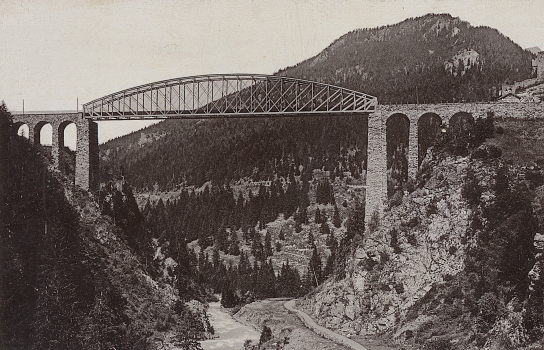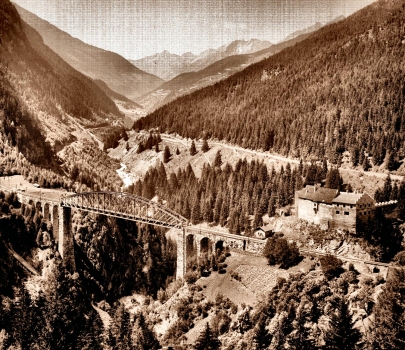General Information
| Name in local language: | Trisannabrücke |
|---|---|
| Beginning of works: | November 1882 |
| Completion: | 1884 |
| Status: | partially in service |
Project Type
| Structure: |
approach viaducts: Semi-circular arch bridge main span: Through truss bridge |
|---|---|
| Function / usage: |
Railroad (railway) bridge |
| Material: |
Structurae Plus/Pro - Subscribe Now! approach viaducts: Masonry bridge main span: Iron bridge |
Location
| Location: |
Landeck, Tyrol, Austria |
|---|---|
| Replaced by: |
Trisanna Bridge (1964)
|
| Coordinates: | 47° 6' 58.53" N 10° 29' 28.46" E |
Technical Information
Dimensions
| main span | 120 m | |
| height | 86 m |
Materials
| superstructure |
wrought iron
|
|---|
Chronology
| November 1882 | Construction begins. |
|---|---|
| 1908 | Bridge is strengthened due to higher train loads. |
| 1914 — 1914 | Plans for to replace the bridge with a concrete arch. |
| 1922 | Bridge strengthened by transforming it into a lenticular truss. |
| 16 November 1964 | Bridge is replaced by an steel tied-arch structure. Traffic is interrupted for only 10 hours. |
Excerpt from Wikipedia
The Trisanna Bridge (German: Trisannabrücke) is a 211-metre (692 feet) long viaduct carrying the Arlberg railway over the Trisanna river just southwest of Pians, a district of Landeck (Tyrol) in Austria. The bridge spans the Paznaun valley and Trisanna gorge, forming part of one of the most important east-west railway routes in the Alps.
At the time of ist completion in 1884, it was the longest steel support structure in the world. It is still considered by many to be amongst the finest bridges in Austria, and is overlooked on ist eastern side by Wiesberg Castle. Together with the castle, the bridge has formed the backdrop for thousands of railway photographs.
Geography
The Arlberg railway is one of only two east-west railway connections across the Austrian Alps, and thus, the route has strategic importance. The bridge is located between the stations of Pians and Strengen, in the Austrian state of Tyrol. The terrain surrounding the bridge is highly mountainous, the nearest major peak being the 3,168-metre (10,394 feet) high Hoher Riffler.
Due to the steep gradient of the railway, the bridge deck is constructed on a gradient of 26%.
History
First bridge (1882-1922)
The first incarnation of the present bridge was built concurrent with the construction of the Arlberg railway from 1882 to 1884. This structure was similar to the present bridge, and comprised masonry arches 55 metres (180 ft) high supporting the main span, which was a 120 metres (390 ft) long through truss bridge built of iron. The bridge was commissioned by Julius Lott, the builder of the Arlberg railway, who entrusted Viennese expert Ludwig Huss to design and build the bridge.
Huss had many challenges, including the exposed and mountainous location, and the need to make sure the bridge was properly able to withstand the considerable braking forces from trains descending the valley. More than 400 workers were employed to construct the bridge, and the bridge was officially opened on September 21, 1884.
The bridge was strengthened several times in the early 20th century, most notably in 1908 due to increasing train loads. There were plans in 1914 to replace the bridge with a concrete arch, and possibly move the location of the bridge, however the onset of the First World War meant the plans never came to fruition.
Text imported from Wikipedia article "Trisanna Bridge" and modified on 7 January 2022 according to the CC-BY-SA 3.0 license.
Participants
Currently there is no information available about persons or companies having participated in this project.
Relevant Web Sites
Relevant Publications
- (1986): Brücken. Historische Entwicklung - Faszination Technik. 2nd edition, Verlag Anton Schroll & Co., Vienna (Austria), pp. 161, 163.
- (1956): Brücken. Karl Robert Langewiesche Verlag, Königstein im Taunus (Germany), pp. 95.
- (1998): Meisterwerke der Ingenieurbaukunst. Bundesanzeiger Verlag, Cologne (Germany), pp. 169-182.
- (1999): Le Passage. 1st edition, Everest Communication, Luxembourg (Luxembourg), pp. 34-35.
- (1921): Ueber die Bewegungen der Hauptpfeiler-Köpfe der Trisannabrücke an der Arlbergbahn. In: Schweizerische Bauzeitung (1883-1946), v. 78, n. 18 (29 October 1921).
- About this
data sheet - Structure-ID
20000467 - Published on:
12/11/1999 - Last updated on:
29/01/2019







